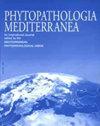中国葡萄黑脚病病原菌研究
IF 1.9
3区 农林科学
Q2 AGRONOMY
引用次数: 6
摘要
葡萄树干病(GTDs)是全球葡萄种植区最具破坏性的疾病。黑脚病是影响年轻葡萄园和苗圃的重要GTD之一。这种疾病在中国还没有报道。2017年和2019年,在中国的广西、河北、宁夏、山西和新疆进行了实地调查。在调查的葡萄园中,出现黑脚症状的植物的发病率为0.1%至1%。从五个省采集了枝条和茎干发育不良、叶片褪绿、树干或根系坏死的植物样本。总共从有症状的组织中获得了50个真菌分离株。根据形态学和多基因系统发育分析,共鉴定出5个种,分别为Cylindrocladiella lageniformis、Dactylonectria torresensis、D.macrodidyma、D.alcacerensis和Neonectria sp.1。使用葡萄“夏黑”的年轻、健康的分离绿芽和盆栽3个月大的“夏黑”插条来评估致病性。接种的分离芽在7天后出现坏死,接种的插条在80天后出现坏死。从坏死的病变中重新分离真菌。在这五个物种中,大型双足线虫的攻击性最强。这是我国首次报道了与黑足相关的C.lageniformis、D.toresensis、D.macrodyma、D.alcacerensis和Neonectria sp.1。这项研究提高了人们对中国黑足相关真菌的认识,并将有助于制定该疾病的控制措施。本文章由计算机程序翻译,如有差异,请以英文原文为准。
Fungal pathogens associated with black foot of grapevine in China
Grapevine trunk diseases (GTDs) are the most destructive diseases in grape-growing regions worldwide. Black foot is one of the important GTDs affecting young vineyards and nurseries. This disease has not been reported in China. During 2017 and 2019, field surveys were carried out in the Guangxi, Hebei, Ningxia, Shanxi, and Xinjiang provinces of China. Incidence of plants with black foot symptoms was 0.1% to 1% in the surveyed vineyards. Plant samples with poorly developed shoots and canes, chlorotic leaves, and necrotic trunks or roots were collected from the five provinces. In total, 50 fungal isolates were obtained from symptomatic tissues. Based on morphological and multi-gene phylogenetic analyses, five species were identified as Cylindrocladiella lageniformis, Dactylonectria torresensis, D. macrodidyma, D. alcacerensis and Neonectria sp.1. Pathogenicity was assessed using young, healthy detached green shoots of grapevine ‘Summer Black’ and potted 3-month-old ‘Summer Black’ cuttings. Inoculated detached shoots developed necroses after 7 d, and inoculated cuttings after 80 d. Fungi were re-isolated from necrotic lesions. Among the five species, D. macrodidyma was the most aggressive. This is the first report of C. lageniformis, D. torresensis, D. macrodidyma, D. alcacerensis, and Neonectria sp. 1 associated with black foot in China. This study has enhanced knowledge of the fungi associated with black foot in China, and will assist development of control measures for this disease.
求助全文
通过发布文献求助,成功后即可免费获取论文全文。
去求助
来源期刊

Phytopathologia Mediterranea
生物-植物科学
CiteScore
4.40
自引率
8.30%
发文量
28
审稿时长
6-12 weeks
期刊介绍:
Phytopathologia Mediterranea is an international journal edited by the Mediterranean Phytopathological Union. The journal’s mission is the promotion of plant health for Mediterranean crops, climate and regions, safe food production, and the transfer of new knowledge on plant diseases and their sustainable management.
The journal deals with all areas of plant pathology, including etiology, epidemiology, disease control, biochemical and physiological aspects, and utilization of molecular technologies. All types of plant pathogens are covered, including fungi, oomycetes, nematodes, protozoa, bacteria, phytoplasmas, viruses, and viroids. The journal also gives a special attention to research on mycotoxins, biological and integrated management of plant diseases, and the use of natural substances in disease and weed control. The journal focuses on pathology of Mediterranean crops grown throughout the world.
The Editorial Board of Phytopathologia Mediterranea has recently been reorganised, under two Editors-in-Chief and with an increased number of editors.
 求助内容:
求助内容: 应助结果提醒方式:
应助结果提醒方式:


